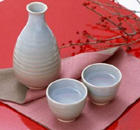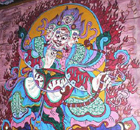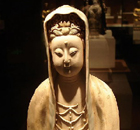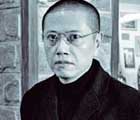Heritage
Yangge
(chinaculture.org)
Updated: 2008-03-21 11:24
 |
Large Medium Small |
(Changli Ground Yangge, Guzi Yangge, Jiaozhou Yangge, Haiyang Dayangge, yangge in Northern Shaanxi, Fushun Ground Yangge)
Year: 2006
Sort: Folk Dance
Area: Hebei, Liaoning, Shandong and Shaanxi provinces
Serial No.: Ⅲ-2
Yangge is a representative collective folk dance that combines music, dance and feats, with a long history and diversified forms, each distinguished by different manipulations of the silk handkerchiefs and different movements of the feet. The main kinds include silt yangge and ground yangge.
Yangge originated from rice planting and farming, and is popular throughout China's countryside. Also, it has some connection with ancient eulogy songs sung in sacrifices to the God of the Farm. During its development, it incorporated much from farming songs, folk songs, folk wushu (martial arts), acrobaticsand traditional operas. By the Qing Dynasty (1644-1911), yangge had spread across the country.
Yangge comes in different styles according to areas or its form, for example, the Guzi Yangge in Shandong, the Yangge in northern Shaanxi, the Ground Yangge in Hebei, Beijing and Liaoning, the Manchurian Yangge and the Stilts Yangge. Other forms such as the Huagu (Flower Drum), Huadeng (Festive Lantern), Caicha (Tea-Leaf Picking) and Yingko Yangges are also very popular. All of them express happiness.
There is no fixed number of performers; it could be two or three, or 20, or even over a hundred. The performers are dressed up, each having a red silk band at waist and a hat folded out of colored papers. Female performers also have a fan and most male performers use a waist drum. The accompanying music instruments include suona, gong, drum and cha (two pieces of thin circular copper plates, each having a small part at center punched out for a hand to hold).
The time when most people perform yangge is the first 15 days after the Chinese New Year. In some villages yangge teams go family by family to each family's yard to dance. In turn, the family gives some gifts to the team and some families also set off fireworks.
Nowadays, yangge has spread into city parks, streets and squares and evolved into a kind of popular exercise for urban dwellers.
Changli Ground Yangge
Declarer: Changli county, Hebei province
The Ground Yangge in Changli county is one of the most representative local folk dances, popular in eastern Hebei province. It came into being in the Yuan Dynasty (1271-1368).
Roles in the Ground Yangge include niu (girls), chou (clown), gongzi (young men) and laokuai (shrewish old women). Except for laokuai, who hold a wooden club, all others dance with a folding fan in their hands. The most interesting role is chou, who is charmingly naive, kind, humorous and optimistic, making the audience burst into laughter from time to time. The three schools of Changli Ground Yangge - Zhou, Zhang and Lu, are widely known throughout the country.
Guzi Yangge
Declarer: Shanghe county, Shangdong province
The Guzi Yangge (or drum yangge), one of the three Yangge forms in Shangdong province, originated in theNorthern Song Dynasty(960-1127) and prevailed during the Ming and Qing dynasties (1368-1911). The dance, accompanied by playing a small drum similar to the tambourine, is popular in rural areas of Shanghe and Huimin.
It is a large-scale dance played during the Spring Festival or other festivals and holidays. The performers have good organization and are carefully divided. When the Spring Festival comes, each village organizes the youth to learn and rehearse, guided by prestigious artists. The performing team is usually composed of over 40 performers, who are divided into five roles: santou (umbrella), guzi (drum), bangchui (stick), lahua (flower) and chou (clown), each with its unique appeal. For instance, santou acts smoothly, guzi is bold and unconstrained, bangchui is as spry as a cricket, and lahua is quick and neat. People performing Lahua usually hold a folding fan and a handkerchief.
The well-trained dancers transform their formations regularly. Their actions are standard and the performance has a strong local flavor. About 100 kinds of formations (or team patterns) are preserved. Of all the yangges in China, the drum yangge has the most diversified formation.
Jiaozhou Yangge
Declarer: Jiaozhou City,Shandong Province
Jiaozhou Yangge, one of the three yangge forms in Shandong Province, is also known as Ground Yangge. It originated in the Qing Dynasty (1644-1911) and is prevalent in Xiaotun Village, Jiaozhou City. It is a collective dance usually composed of dozens of performers, who are divided into six roles: gaoyaoke, cuihua, shannv, xiaochou, bangchui and guzi. The dance reflects the particular countryside charm, and is valuable for its aesthetics and information for artistic research.










